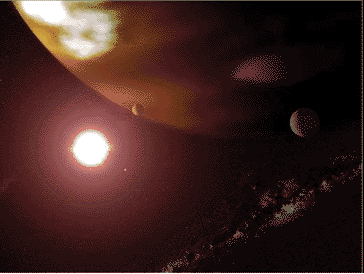The researchers used the Hubble Space Telescope to observe the twinkling star in the sky as it moves back and forth due to the gravitational pull of a planet orbiting it.

A planet discovered far beyond the solar system has been weighed with greater precision for the first time, a weighing that confirmed the previous estimate of its mass - the WOBBLE method used to locate planets outside the solar system.
The researchers used the Hubble Space Telescope to observe the twinkling star in the sky as it moves back and forth due to the gravitational pull of a planet orbiting it.
The star, Gliese 876, is 15 light years from Earth. Its planet, Gliese 876b, was discovered earlier using indirect methods that measure the displacement of light waves that indicate whether the star is moving toward or away from Earth. This Doppler method is very popular and is known as the wobble method and it is also known as the radial velocity approach, and it served for seven years as the only tool to confirm the discovery of a planet outside the solar system.
However, the Doppler method has limitations. It cannot detect a side-to-side movement of a star (except, as mentioned, only if the angle is such that from time to time it moves away or approaches, if the planet is on its far side or if it surrounds the star in a perfect circle in the sky for us, meaning that we are perpendicular to the plane of its whip. Also, Even in the other cases it is difficult to know the exact mass, but only to provide a lower limit and leaves open the possibility that the companion is something larger than a planet, such as an undeveloped star known as a brown dwarf.
The new observations called astrometry were designed and carried out by George Fritz Benedict of the University of Texas at Austin. They revealed the exact shape of the orbit and thus allowed astronomers to accurately calculate the planet's mass. The mass of Gliese 876b is now estimated to be between 1.89 and 2.4 Jupiter masses. Previous estimates gave an estimate of between 1.9 out of 100 of Jupiter.
The method works like the scales. You have something on one side and a short rod, and you have to find out what's on the other side so that the scales balance. Benedict and his colleagues knew how long it takes the planet to orbit its sun - 61 days, so they observed the position of the star when the planet was at two opposite points of the star. They employed Hubble's precision position sensors that are normally used to position and position the observatory.
"The idea was to measure the degree of movement of the star in the sky," said Benedict. "By measuring its zigzag in the sky and the shape of the orbit we can determine the mass of the object surrounding it." The team found a signature that could be interpreted as solid evidence for the existence of a planetary-mass object around the star. said. A second planet is also supposed to orbit the star, but its presence has not been located or investigated.
Know planets outside the solar system
Shai Zucker, the co-discoverer of Prof. Zvi Maza draws our attention to the fact that as part of the detection of the atmosphere, an accurate estimate of the mass of the planet was also made using a method similar to the one reviewed in this news. It should be noted that the ignoring of the work of Maza and Zucker was knowing that I took the material from her and with it the forgiveness.
Thanks to the personal signature of sodium - how the atmosphere of a planet outside the solar system was discovered for the first time
